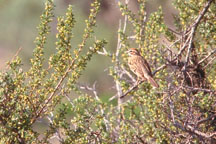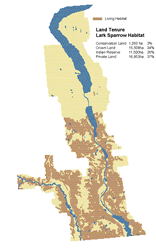|
Habitat Atlas for Wildlife at Risk
Lark Sparrow
Chondestes grammacus

Lark
Sparrow
|

- Length: 14-16 cm.
- Single dark central breast spot and bold, quail-like
head pattern, with a chestnut ear patch and striped
crown.
- Black tail with distinctive white borders and
corners.
- Loud, varied song.
Status:
British Columbia Red List
Special Significance
The Lark Sparrow is a distinctive summer resident in
the lower elevation grasslands of the Okanagan Valley
and is common only in the few remaining tracts of
antelope-brush. British Columbia populations have
presumably decreased because of the loss of shrub-grassland
habitats. The remaining dry shrub-grasslands must
be properly managed and maintained to provide the
habitat these birds require. Improving the condition
of rangeland to provide tall, healthy bunchgrasses
and low shrub density should be a priority for habitat
preservation. To help ensure the survival of Lark
Sparrows, further detailed information is required
on their habitat requirements.
Distribution
- Lark Sparrows are widely distributed in the Southern Interior
of British Columbia, but the vast majority of the provincial population
is in the Okanagan Valley south of Penticton and
the Similkameen Valley
southeast of Keremeos; a few breeding records from
Vernon and Shuswap Lake area.
- Elevational range is generally below 750 metres, though
it may occur up to 1200 metres.
Habitat
- Prefer areas with tall shrubs mixed with open grassland; antelope-brush
rangelands are the preferred habitat in British
Columbia, especially those on the east side of the Okanagan Valley
from Skaha Lake south
to Osoyoos.
- Nests are placed on the ground concealed by shrubs
or grass clumps.
Reproduction
- Birds arrive early- to mid-May.
- Four eggs are usually laid and nesting occurs from
mid-May to early July.
- Young birds may fledge as early as second week of June.
Food Habits
- Lark Sparrows consume a variety of seeds and insects such as grasshoppers
and crickets.
Interesting Facts
- Males court the females by strutting on the ground like a turkey
cock, with wings trailing and tail spread showing
white feathers, and bubbling fragments of song.
- Birds sing in flight as well as on the ground; the
loud, warbling song gives the species its name.
Threats
- Loss of low elevation grasslands due to urban development.
- Use of insecticides and herbicides could be directly
harmful or reduce prey.
Management Considerations
- Preserve sections of remaining low elevation,
dry shrub-grasslands.
- Employ land management practices which encourage
the growth of healthy native grassland
plants.
- Protect known nest sites from human disturbance.
- Seed rangelands with native grasses whenever
possible.
- Carefully monitor and reduce use of pesticides.
|
References
1. Shepard, M.G. 1995. Draft. Status Report on the Lark Sparrow (Chondestes
grammacus) in British Columbia. Ministry of Water, Land and Air Protection
Lands and Parks, Victoria, British Columbia.
2. Cannings, R.A., R.J. Cannings and S.G. Cannings.
1987. Birds of the Okanagan Valley, British Columbia. Royal British
Columbia Museum, Victoria, BC.
|